If there’s a reaction that summed up how David Phelps felt during his terrible, horrible, no good, very bad September of 2020, it’s definitely this one:
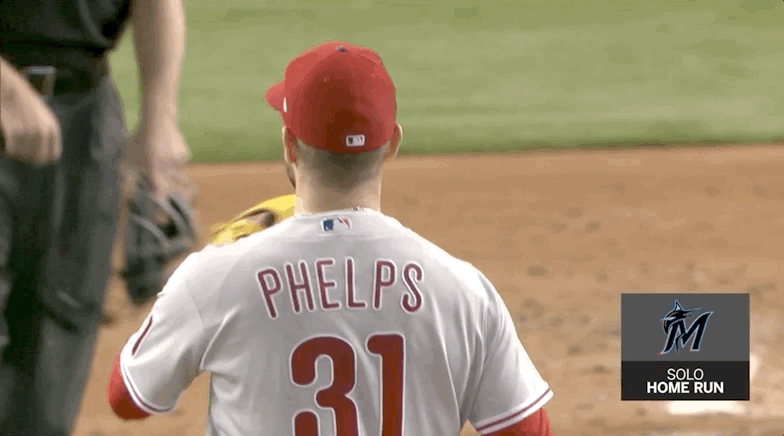
That’s the look of a man who can’t believe what’s happening — a typically effective veteran reliever who was throwing the ball as well as he ever had while simultaneously experiencing unprecedentedly unfortunate results. At the best of times, baseball can be a maddening, torturous, will-testing game for those who play it at the highest level. But for Phelps — who signed a one-year, $1.75-million deal with the Toronto Blue Jays in February — the final four weeks of the 2020 season were among the most agonizing of his career.
“I don’t have an answer as to what happened,” he said. “It was wild. I wasn’t necessarily trying to pitch in a different way. It was just like every ball that was hit in the air was going out. It definitely took some soul searching at the end of the season to wash it away. It took a good, long while.”
Here’s what Phelps is talking about. The reaction above came during a mid-September outing immediately after he gave up this opposite-field shot to Miami Marlins centre fielder Starling Marte:
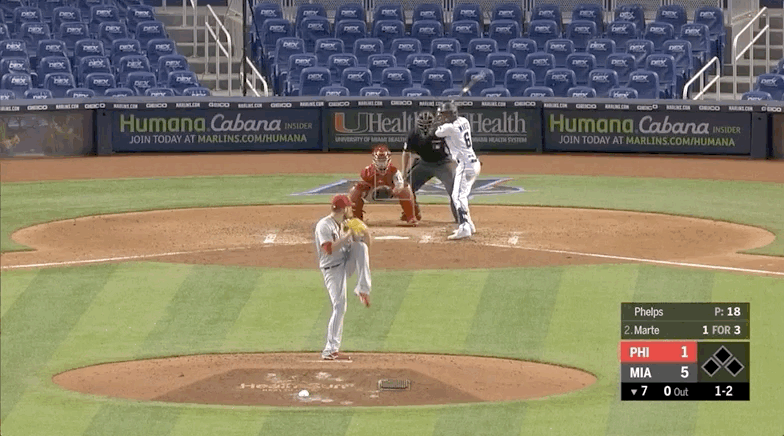
That’s a cutter away from a right-handed hitter, a bread-and-butter pitch for Phelps throughout his eight-season MLB career. Do you know how many homers Phelps has allowed to right-handed hitters off cutters anywhere on the outside third of the plate over 608.2 innings pitched in the majors? One. You just saw it.
And it’s not only that Phelps doesn’t allow homers on pitches like that. He doesn’t allow damage, period. Over the course of 291 big-league appearances, Phelps has located a cutter on the outer third of the plate or beyond to a right-handed hitter 278 times and allowed only 11 hits — 9 of them singles. It just doesn’t happen.
You know what else rarely happens? Phelps allowing an opposite field homer to a right-handed hitter like Marte. Only eight righties have ever taken Phelps deep to right field — six of them coming in the first four seasons of his career. Over the 181 games he’s appeared in since 2016, against the 443 right-handed hitters he’s faced in that span, Phelps has allowed only two opposite-field shots: a two-run Bobby Dalbec homer and the solo shot Marte hit. Both came within the span of seven days last September.
That’s the kind of month Phelps had. Anything that could go wrong, did. All was well over the first half of his season, as he pitched to a 2.77 ERA through 12 appearances with the Milwaukee Brewers. But when he was acquired by the Philadelphia Phillies at the trade deadline to reinforce the club’s terminally plagued bullpen — which featured a collective ERA north of seven — Phelps didn’t provide a cure for the disease. He was consumed by it.
He allowed eight runs over his first six appearances with Philadelphia, giving up homers in four of them. After walking only two batters through his first 15 innings of the season, he walked two in the span of three batters during an outing against the Boston Red Sox, sandwiching Dalbec’s opposite field shot. In two of his 10 games in a Phillies uniform, Phelps didn’t register an out; in two others, he recorded only one. It was by far the worst stretch of his career
And the nadir came at Marlins Park where Marte hit that opposite-field homer. Phelps’ incensed reaction to it had a lot to do with a lot of things. But a big part of it was actually what happened an inning earlier, when Miguel Rojas did this to the second pitch Phelps threw in his outing:
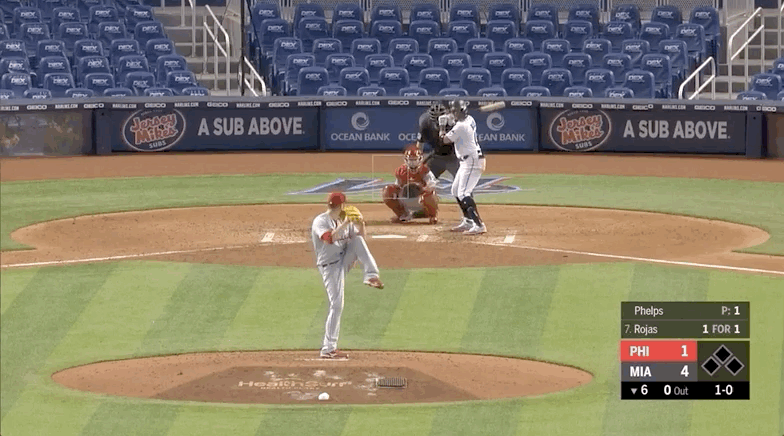
That’s a pretty good sinker that started down and on the plate before tailing inside the zone, where Rojas was somehow able to pull in his barrel and golf the ball 416-feet over the left field bullpen. Throwing that sinker inside to righties is just as crucial for Phelps as his cutter away from them. Let’s play this game again. Phelps has thrown 813 two-seam fastballs to right-handed hitters in his career. Do you know how many have ended up being homers?
Six. Do you know how many have ended up being homers over Phelps’ 181 games since 2016? Two. Randal Grichuk got one in 2016; then Rojas hit his in 2020. Added to the Marte bomb, that makes two of the most unlikely events of Phelps’ career within one outing.
The year 2020 was a weird one for us all. But it’s hard to find a pitcher who had a weirder month of September than Phelps. And even more granularly, a weirder two outings at Marlins Park, where Phelps spent three seasons of his career. Things were happening that had never happened before. Which is why he was left looking around, incredulous:
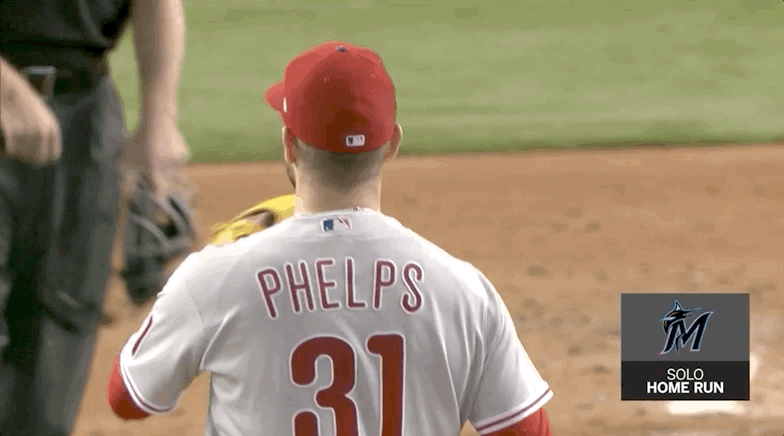
“That series in Miami was nuts,” he said. “If you look at my face — I just remember thinking, ‘I played in Miami for three years. I didn’t give up opposite field home runs there very often.’”
For Phelps, the 2020 season and the 6.53 ERA he pitched during it — 12.91 in September with the Phillies, but who’s counting? — all came down to home runs. He surrendered seven over 20.2 innings pitched; 11 of the 15 runs he allowed all season scored via long ball.
“I was just really bad at not giving up home runs,” he said. “I definitely went into the off-season realizing that we needed to dig into it a little bit.”
And he did, working with the developmental staff who have programmed his winter training for years at FullReps Training Center in Camp Hill, Pa. They pored over his pitch usage, his movement, his spin efficiency, how Phelps was using his arsenal and, more importantly, where.
One issue they identified was a tendency for his four-seam fastball to end up thigh-high — a danger zone against modern hitters — when Phelps tried to locate it toward the bottom of the zone. He started throwing off a mound earlier this winter than he has during past off-seasons to specifically address that issue. He tweaked his movement patterns on the mound so that he can repeat his delivery more consistently and keep himself in a position where his inevitable misses end up off the plate rather than over the heart of it.
It’s not an adjustment any fan will notice while watching Phelps pitch this season. But it’s something. And it lets the 34-year-old feel like he’s at least taken a step to address his 2020 issues. That mental clarity is perhaps the biggest benefit of all, because the hardest part of a situation like his is not doing too much — not doing something unnecessarily.
Coming off a season like the one Phelps had, the obvious urge is to change this, tweak that. Tinker and adjust for the sake of doing something in response to the tremendously unfortunate results he’d faced. But the closer you look at Phelps’ season, the clearer it gets that he doesn’t need a drastic overhaul. He was just ridiculously unlucky.
[snippet id=4722869]
Phelps was a 94th percentile MLB pitcher in exit velocity allowed (85 m.p.h.) in 2020. Aside from the homers, he surrendered only a dozen other hits all season — 11 of them singles. He set career highs in strikeout (36.5 per cent) and walk rate (5.9), featuring two separate pitches with whiff rates of 30 per cent or higher. Take just a couple home runs off his ledger — say, the incredibly unlikely ones Marte and Rojas hit in Miami — and suddenly his outcome numbers look a lot more like those of a quality MLB reliever.
Of course, it doesn’t work like that. The balls left the yard. But home run rates are extremely susceptible to variance and luck — particularly for relievers who have such limited opportunities for their numbers to normalize throughout a season. And particularly in a season that ran only a third of the length a normal one would.
Here’s a point of reference. Generally excellent New York Mets reliever Edwin Diaz was considered to have experienced tremendously bad luck in 2019 when he allowed 15 home runs in 58 innings, ballooning his ERA to 5.59 after he posted a 1.96 mark in 2018. That theory was confirmed when Diaz returned to the norm with a 1.75 ERA in 2020. Diaz’s home run to fly ball rate during that extraordinarily hard-luck 2019 season? It was a jarring 26.8 per cent. Phelps’ HR/FB rate in 2020 was 41.2.
You can see why the Blue Jays bet on him bouncing back. If Phelps throws the ball as well as he did in 2020, and combines it with more favourable luck on balls in play, his $1.75-million salary will look like an extreme bargain.
Phelps’s profile is an unusual one in today’s relief era of hulking, max-effort throwers who use high-octane, oft-unwieldy fastballs to set up a high-spinning breaking weapon. He doesn’t throw exceptionally hard — sitting around 94 m.p.h. he’s just a tick above MLB average — and uses some form of a fastball 75 per cent of the time, whether it’s straight, sinking or cutting.
He plays a curveball with average spin off those three fastball variations, producing a remarkably even pitch mix. In 2020, hitters had a near identical chance of seeing a cutter (26.9 per cent usage), curveball (26.6), sinker (24.1) or four-seamer (22.4) out of his hand. It looks a lot more like the kind of arsenal a starter would use to get two or three times through a lineup, rather than one a reliever would use to get two or three high-leverage outs.
That’s because Phelps used to start. He did it throughout his minor-league career and for stretches during his first three seasons in the majors with the New York Yankees. But a pivot point came shortly after Phelps was traded to the Marlins ahead of the 2015 season. Juan Nieves, then Miami’s pitching coach, sat Phelps down and told him “you’re just surviving” with a pitch mix that, at the time, was heavy on sinkers and cutters. Phelps told him he felt the same way. And set off to do something about it.
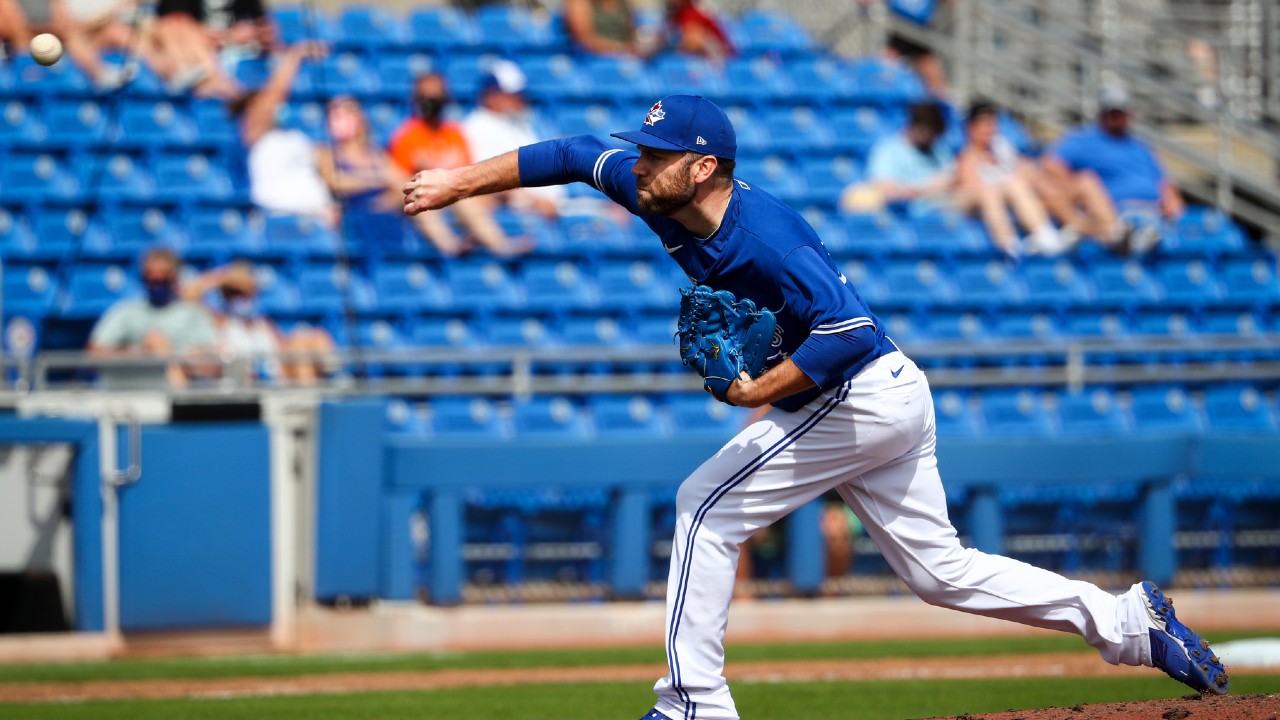
David Phelps pitches during a spring training game on March 5, 2021. (Toronto Blue Jays)
That off-season, he started a weighted ball routine while training at home in St. Louis, which helped add velocity to all of his pitches, particularly a four-seam fastball he began utilizing much more often. He upped his curveball usage as well, and abandoned a sider and changeup he’d thrown over the first several seasons of his career. He became less reliant on merely two pitches and began evenly mixing and matching with four. That coincided with a shift to a permanent relief role. And since the wider arsenal was working at the time — Phelps pitched to a 2.28 ERA over 86.2 innings in 2016 — he decided to keep it rolling.
After losing his 2018 season to Tommy John surgery, Phelps returned with as steady of a pitch mix as ever in 2019. And after throwing a little softer post-operation, he rediscovered his velocity in 2020, averaging 94 m.p.h. on both his four-seamer and sinker. His four-seamer, in particular, plays up in a big way and generated a remarkable 42.9 per cent whiff rate in 2020 — MLB’s fourth-highest among pitchers to throw at least 80 four-seamers last season.
The fact it’s not a particularly fast or spinney pitch speaks to how well Phelps uses it — and uses the rest of his repertoire to set it up. A lot of that is not being afraid to throw elevated four-seamers, trying to miss bats up in the zone against hitters looking down to guard against sinkers and cutters on the edges of the plate. Command is everything. Hitters can’t sit on those elevated fastballs if they know Phelps is liable to drop a curveball in for a strike or pick corners with sinkers and cutters.
“When I was drafted, I was 88-92 (miles per hour.) I had to be a guy that commanded the baseball. That’s why I had success in the minor-leagues. That’s why I got promoted when I did — because I had the ability to fill up the strike zone,” Phelps said. “It’s just something that I’ve always prided myself on — being a guy that could throw strikes. I’ve had spurts where I don’t necessarily fill it up as much as I want to. But it’s a big part of the reason why I’m even still here.”
Here’s who’s within a Blue Jays bullpen that has somewhat quietly been built out to provide manager Charlie Montoyo with a plethora of imposing, multipurpose options. Kirby Yates, when healthy and on form, is one of the best closers in the game. Jordan Romano and Rafael Dolis both struck a ton of hitters out while thriving in high leverage last season. Ryan Borucki is, at worst, a useful weapon against left-handers and, at best, Andrew Miller Lite.
[snippet id=3305549]
Julian Merryweather is versatile and overpowering, capable of facing anywhere from six to nine hitters early or late in games. Tyler Chatwood is an intriguing bounce back candidate with premium stuff, while non-roster invitee Francisco Liriano has pitched impressively this spring and could provide utility against left-handed heavy lineups such as last year’s AL East champion Tampa Bay Rays. And career starters Trent Thornton and T.J. Zeuch represent potential length options featuring difficult-to-barrel stuff.
“We have a lot of guys that can do things different ways to get guys out. We have some young arms that have plus-plus stuff. We’ve got some veteran guys that have had success that don’t necessarily just rely on the overpowering fastball. It’s a really good mix,” Phelps said. “I was just joking the other day, like, ‘I don’t really know where I fit in.’”
Anywhere from the sixth to eighth inning, facing three to six batters, is the likely answer there. Not that modern MLB bullpen usage is ever so predictable. There will no doubt be occasions when Phelps’s services are required earlier or later in games. As with all relievers these days, he simply has to worry about staying ready and getting outs whenever asked.
That’s been the case so far this spring, as Phelps hasn’t allowed a hit or a walk through his first four appearances of camp, striking out half the batters he’s faced. His velocity’s been right where it should be and his four-seamer’s still getting plenty of sneaky swing-and-miss. He’s looked like a guy who worked awfully hard this winter to come into the season feeling his best.
And he did. Not that he’s fighting for a job on the club — he’ll be in Toronto’s bullpen come opening day. But after his terrible, horrible, no good, very bad September, and the off-season of soul searching that ensued, Phelps didn’t want to waste any time turning the page. He wanted the bad luck to end right then and there. And he won’t lie — it’s great to see some results.
“You want to get some of that good momentum going into the season,” he said. “And just help yourself realize that that month of September isn’t defining what you’re doing. Because it was definitely a trying month, for sure.”
[relatedlinks]








